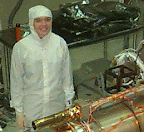Celebrate pink!
By Peggy Ashbrook
Posted on 2009-06-23
 What was your favorite color when you were five? Many young girls like pink, a stereotypically female color.
What was your favorite color when you were five? Many young girls like pink, a stereotypically female color.
Do girls who love pink ever grow up to be women who do work that historically has more often been done by men? What can we do to encourage all children to think of themselves as capable and support an interest in science? Remember to alternate saying “boys and girls” with “girls and boys”? Monitor who we call on and call on girls 50% of the time? Be sure to display pictures of all kinds of people, including women, doing science?
Many women scientists say they pursued a career in science because a teacher or other mentor encouraged them, and believed in their capabilities, say Ashley Campbell and Gerald Skoog in Preparing Undergraduate Women for Science Career, (The College Science Classroom, March/April 2004 33 (5):24-26). This idea is echoed in many of the life stories of women scientists on the National
Aeronautics and Space Administration’s the “Women of NASA” page. Print out and post some of the photos to put in a display of scientists at work to inspire and inform children. and testify to women’s presence in science.
The Institute of Educational Sciences Practice Guide “Encouraging Girls in Math and Science” (2007) recommends five key practices. View it on the U.S. Department of Education website. The practical suggestions from Doing What Works are geared towards middle and high school age students but are food for thought for all of us.

A recent report from a National Research Council panel states, “women are not applying for tenure-track jobs at research-intensive universities at the same rate that they are earning Ph.D.s” although “those who do apply are interviewed and hired at rates equal to or higher than those for men.“ The report also noted that “The surveys revealed that most institutional strategies to try to increase the proportion of women in the applicant pool — such as targeted advertising and recruiting at conferences — did not show significant effectiveness, the report says. One strategy did appear to make a difference: Having a female chair of the search committee and a high number of women on the committee were associated with a higher number of women in the applicant pool.”
Implicit Association Tests taken by half a million people in 34 countries revealed that the stereotype of associating science with males is held by most of the test takers in a study published in the Proceedings of the National Academy of Sciences. Lead investigator Brian Nosek, an associate professor of psychology at the University of Virginia, said in UVA Today, “We found a general tendency, across every country that we investigated, that people on average have an easier time associating science concepts with male, rather than with female.”
Some tactics I use to try to reduce any suggestion of excluding girls from science are to be sure to call on girls at least half the time (yes, I count), use the pronoun “it” when talking about animals whose sex isn’t known or alternate “she” and “he”, post pictures of female and male scientists from many cultures, and ask girls as often as boys to help other children with science questions or problems. My take-away thought on this is that every early childhood teacher can do science activities with their class with eyes open to our own biases, in a way that creates a positive environment for all children for loving science. Much later in their education, some will decide not to pursue a career in science, but it won’t be because they think their gender prevents their success.
Share your tactics by clicking on the word “Comments” below!
Peggy
Disclaimer: The views expressed in this blog post are those of the author(s) and do not necessarily reflect the official position of the National Science Teaching Association (NSTA).


